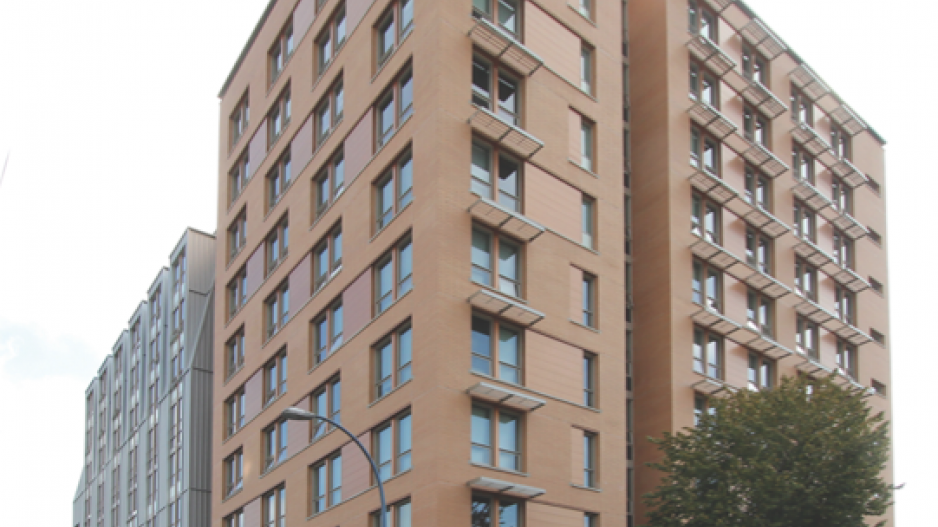The BC Liberal government made a $500 million pre-election promise in mid-September to build more low-cost and subsidized housing. But one Downtown Eastside project is raising questions about its ability to manage costs and schedules.
Politicians, including Housing Minister Rich Coleman, gathered in February 2013 for a photo opportunity early in the construction of the Budzey Building. The 10-storey, 147-suite tower is on the former site of the notorious Drake Hotel and houses needy single mothers and children. It was finished 13 months late and sparked a lawsuit.
In May 2010, BC Housing estimated the project capital cost at $34.6 million. Three years later, it announced $37.1 million in financing for RainCity Housing and Support Society. Streeto-home Foundation granted $2.9 million and city hall donated the land, worth $4 million, and agreed to waive $902,000 in development cost charges, levies and site decontamination. The project missed its April 30, 2014, deadline for substantial performance, and Streetohome confirmed in summer 2014 that concrete forming and elevator installation were partly to blame. The Budzey Building became ready for occupancy in June 2015.
The late delivery sparked a taxpayer bailout of the charity picked to manage the building and a BC Supreme Court breach-of-contract lawsuit.
Last November 6, RainCity quietly assigned its right, title and interest in the project to BC Housing. On April 28, BC Housing filed a statement of claim against Stuart Olson Construction, citing breach of its $30.87 million stipulated price contract signed with RainCity in November 2012.
The court filing said the delays caused unspecified increased costs and expenses for RainCity, which unsuccessfully sought compensation from Stuart Olson. Stuart Olson did not respond to requests by Business in Vancouver for comment.
BC Housing CEO Shayne Ramsay and vice-president of development Michael Flanigan did not respond to interview requests. By email, BC Housing spokeswoman Laura Mathews said there would be no comment on the Budzey Building lawsuit, because it is “currently in litigation.”
Documents released by BC Housing in response to a freedom of information request shed light on more of the problems experienced. March 2016 quantitative and qualitative review reports claim the project came in $580,654 over its committed $42.75 million budget. The report downplayed the cost overrun based on the revision of the city’s in-kind donation of levy reduction and increased hazardous materials costs recovered from the city – “neither of which affect the mortgage as they are in-and-out costs,” it said.
There were 145 change orders for almost $500,000, “not including the $882,097.16 PST [change order] extra when the B.C. [value added taxes] changed from HST to GST/PST.”
The report said the development process was hampered by “the start-and-stop nature of the funding and project approval” and the “city approval process.” The report pointed to various problems with the fire shutters, glass canopies and walkie-talkie communications, plus friction with city hall.
“City delay on demolition and testing was problematic. Need to better incorporate the haz-mat testing, evictions, remediation and demolition into the project process with better transparency and agreement on the timeline and the process.
“Better yet, have the city co-ordinate that work (they want to retain 100% control anyway) and turn over a clean site.”
The documents also said the city’s fast-track approval process was “anything but fast.”
The city’s chief housing officer, Mukhtar Latif, did not respond to requests for comment.
The documents said there needed to be “clear, transparent pricing assumptions with timelines and services better defined” from subtrades, better monitoring of the construction schedule and administration of funds holdback.
“Contractor default insurance and Subguard – never again! It provides no recourse except in the case of insolvency of the prime contractor.”
The challenges included warranty work, higher-than-expected BC Hydro costs and confusion over commissioning and operating budgets.
There was also frustration with the process to achieve Leadership in Energy and Environmental Design (LEED) Gold energy efficiency status. “Can we stop using LEED now?” the report said.
The chief operating officer of project manager Terra Housing admitted gaining the seal of approval from the Canada Green Building Council can be challenging.
“The higher goal of building energy-efficient, sustainable buildings is a good one,” Simon Davie told BIV. “Trying to achieve Gold, it’s a point count to get to your standard; sometimes you chase your final points.” •




